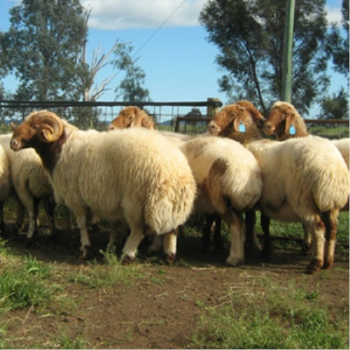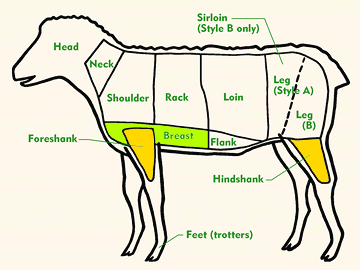
 |

(Simultaneously also a Shᵊlâm•imꞋ, Ish•ëhꞋ & QᵊtōrꞋët![]() )
)![]()
 |
| Awassi fat-tail sheep |
To begin the commissioning ceremony, A•ha•rōnꞋ and his four sons were required to rest their hands on the head of the second aꞋyil, which was for A•ha•rōnꞋ, the original Kō•heinꞋ ha-Jâ•dōlꞋ.
Next, they were directed to shâ•khatꞋ the AꞋyil![]() Mi•lū•imꞋ and take some of its dâm and daub it on the tip of the right ear,
Mi•lū•imꞋ and take some of its dâm and daub it on the tip of the right ear,![]() right thumb
right thumb![]() and right big toe
and right big toe![]() of A•ha•rōnꞋ and his four sons. They were also required to slosh some of the dâm all around the mi•zᵊbeiꞋakh.
of A•ha•rōnꞋ and his four sons. They were also required to slosh some of the dâm all around the mi•zᵊbeiꞋakh.
Then they were then commanded to take some of the dâm, which was on the mi•zᵊbeiꞋakh, with some olive-oil for a mi•shᵊkh•âhꞋ ![]() , and spatter it upon A•ha•rōnꞋ and his four sons and their vestments; so that both they and their vestments became qâ•dashꞋ.
, and spatter it upon A•ha•rōnꞋ and his four sons and their vestments; so that both they and their vestments became qâ•dashꞋ.
You must remove the fat-tail, the kâ•veidꞋ, the ki•lᵊyâhꞋ and all of the kheiꞋlëvꞋ; for this is the AꞋyil ![]() Mi•lū•imꞋ.
Mi•lū•imꞋ.
Next, from the basket of matz•ōtꞋ that is before é‑‑ä, take one ki•kârꞋ of lëkhꞋëm, one khal•âhꞋ of olive-oil lëkhꞋëm and one cracker.
Then you shall put it all in the hands of A•ha•rōnꞋ and his four sons, who shall wave it for a wave-ceremony before é‑‑ä.
Then you shall take it from their hands and turn it into qᵊtōrꞋët ![]() on the mi•zᵊbeiꞋakh for a savory-aroma before é‑‑ä; an ōl•âhꞋ ish•ëhꞋ before é‑‑ä.
on the mi•zᵊbeiꞋakh for a savory-aroma before é‑‑ä; an ōl•âhꞋ ish•ëhꞋ before é‑‑ä.
 |
| AꞋyil (mutton) butcher cuts |
Then take the aꞋyil breast![]() of the A•ha•rōnꞋ’s aꞋyil
of the A•ha•rōnꞋ’s aꞋyil ![]() Mi•lū•imꞋ and wave it for a wave-ceremony before é‑‑ä. Then it shall be your portion for a feast. Thus shall you qi•deishꞋ the aꞋyil breast
Mi•lū•imꞋ and wave it for a wave-ceremony before é‑‑ä. Then it shall be your portion for a feast. Thus shall you qi•deishꞋ the aꞋyil breast![]() of the wave-ceremony.
of the wave-ceremony.
So you shall qi•deishꞋ the aꞋyil breast![]() of the wave-ceremony along with the shank of the tᵊrūm•âhꞋ of A•ha•rōnꞋ’s and his sons’ aꞋyil
of the wave-ceremony along with the shank of the tᵊrūm•âhꞋ of A•ha•rōnꞋ’s and his sons’ aꞋyil ![]() Mi•lū•imꞋ, which is first waved and then raised-up.
Mi•lū•imꞋ, which is first waved and then raised-up.
This shall belong to A•ha•rōnꞋ and his sons, from Bᵊn•eiꞋ-Yi•sᵊrâ•eilꞋ, for a khōq-ō•lâmꞋ because it is a tᵊrūm•âhꞋ. It shall continue to be a tᵊrūm•âhꞋ, for their tᵊrūm•âhꞋ for é‑‑ä, from the zᵊvâkh•eiꞋ-shᵊlâm•imꞋ of Bᵊn•eiꞋ-Yi•sᵊrâ•eilꞋ.
Also, the qōꞋdësh vestments shall belong to A•ha•rōnꞋ and his sons, in which to be mâ•shᵊkh•âhꞋ ![]() and qi•deishꞋ.
and qi•deishꞋ.
Whichever of A•ha•rōnꞋ’s sons may officiate as kō•heinꞋ in his stead shall suit himself up in them for shëvꞋa days; whomever comes into the ŌꞋhël Mō•eidꞋ to officiate in the QōꞋdësh.
So you shall take the AꞋyil ![]() Mi•lū•imꞋ and stew its bâ•sârꞋ in a mâ•qomꞋ qâ•dōshꞋ. Then A•ha•rōnꞋ and his sons may eat the bâ•sârꞋ of the aꞋyil and the lëkhꞋëm that’s in the basket by the pëtꞋakh of the ŌꞋhël Mō•eidꞋ, Thusly may they eat those items with which they have celebrated ki•pūrꞋ; commisioning them and making them qa•deishꞋ. However, no zâr may eat of it because it is qōꞋdësh. So, if any of the bâ•sârꞋ AꞋyil
Mi•lū•imꞋ and stew its bâ•sârꞋ in a mâ•qomꞋ qâ•dōshꞋ. Then A•ha•rōnꞋ and his sons may eat the bâ•sârꞋ of the aꞋyil and the lëkhꞋëm that’s in the basket by the pëtꞋakh of the ŌꞋhël Mō•eidꞋ, Thusly may they eat those items with which they have celebrated ki•pūrꞋ; commisioning them and making them qa•deishꞋ. However, no zâr may eat of it because it is qōꞋdësh. So, if any of the bâ•sârꞋ AꞋyil ![]() ha-Mi•lū•imꞋ or of the lëkhꞋëm remain in the morning, you must incinerate the left-overs in fire. It may not be eaten because it is qōꞋdësh.
ha-Mi•lū•imꞋ or of the lëkhꞋëm remain in the morning, you must incinerate the left-overs in fire. It may not be eaten because it is qōꞋdësh.
Thusly shall you do for A•ha•rōnꞋ and his four sons, according to everything that I have tzi•wâhꞋ you. You shall spend shëvꞋa days filling ![]() their hand.
their hand.

Optional parental preparation:
29.20 Dâm on right ear—In ancient belief, shᵊkhit•âhꞋ of a kâ•sheirꞋ animal for food or sacrifice required returning the slain animal’s nëphꞋësh, which the ancients believed to be in the dâm, to its Creator; primarily by pouring the dâm into the ground (since that’s what happens to the blood of most animals, which are killed and eaten by other animals).
Since only one nëphꞋësh was believed to be allotted per animal, the sum of its dâm, in toto, was deemed to comprise one single and indivisible element of that particular animal. Hence, by daubing some of the dâm on the qᵊrân•ōtꞋ of the Mi•zᵊbeiꞋakh, they seem to have theorized that they were routing some of that single nëphꞋësh through the mi•zᵊbeiꞋakh up (in smoke) to the Creator. Similarly, this would seem to be bringing the kō•han•imꞋ into that loop; part of the nëphꞋësh returning to the Creator via the mi•zᵊbeiꞋakh and part via the officiating kō•heinꞋ; spiritually “sewing” them together with a spiritual-communication thread of the sacrificed nëphꞋësh.
The symbolism then clarifies: éÈîÄéï connoted predominance. We hear through two ears. We must hear both sides of any argument or discussion. The predominant ear, the one we give preference, must be attuned to the Spiritual Realm of é‑‑ä to discern ë•mëtꞋ and tzᵊdâq•âhꞋ from false/noise in order to render a correct mi•shᵊpâtꞋ—in accordance with Ta•na"khꞋ. ![]()
29.20 Dâm on right thumb—In the same theme as the ear,![]() we have free will, choosing what we do. Including the predominant thumb in “the spiritual loop” signifies always choosing the action that reflects molding our will to the Will of é‑‑ä—explicit in Ta•na"khꞋ.
we have free will, choosing what we do. Including the predominant thumb in “the spiritual loop” signifies always choosing the action that reflects molding our will to the Will of é‑‑ä—explicit in Ta•na"khꞋ. ![]()
29.20 Dâm on right big toe—In the same theme as the thumb,![]() we choose where we go. Including the predominant toe in “the spiritual loop” signifies always choosing where we go by molding our will to the Will of é‑‑ä—explicit in Ta•na"khꞋ.
we choose where we go. Including the predominant toe in “the spiritual loop” signifies always choosing where we go by molding our will to the Will of é‑‑ä—explicit in Ta•na"khꞋ. ![]()
29.22—”Fat tail”—Sheep don’t have “fat tails” except for this particular species: Awassi. Notice the difference from the tails of other species of sheep.
29.26 aꞋyil breast (or flaps) of mutton — an inexpensive, low-quality, high-fat, tough, scraggy cut of sheep; often roasted in a vertical kebab rotisserie. Thin roasted shavings are sliced from the surface to fill laffa bread sandwiches (Arabic name, shwarma). ![]()
Questions you might anticipate that your child might raise and be prepared to discuss:
What does it mean to daub a liquid, ointment or paste onto something? To slosh a liquid onto something? To spatter some liquid onto something?
What are vestments?
What does stew mean?
![]()
 |
 |